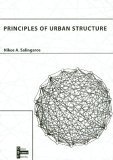Items related to Principles of Urban Structure

Synopsis
This book explains how cities actually work. It will serve as a guide and inspiration for planners to re-humanize our cities using the latest technologies and recent understanding from science and mathematics. The dogma of mainstream urbanism cannot cope with the changes in technology, culture and science of the last decades. The heritage we are left with is an overly asphalted and sterile concrete environment. Therefore this book addresses the needs of professional urbanists, sutdents and teachers, who wish to understand how and why cities are successful or not, depending on their form, components, and substructure. Most of the needs are related to the urgent search for new instruments of urban planning and design, to which this book contributes conceptually by showing how to connect the fractal city on multiple levels. There is an increasing awareness that a city needs to be understood as a complex interacting system. Different types of urban systems overlap to build up urban complexity in a living city. This raises the need for using concepts such as coherence, emergence, information, self-organization and adaptivity. This book relates these concepts to the city, shows how to operationalize them, and hopefully marks the beginnings of an urban science.
"synopsis" may belong to another edition of this title.
About the Author
"One of 50 visionaries who are changing your world." -- Utne Reader. Ranked 11th among "The top 100 urban thinkers of all time". -- Planetizen. Nikos Angelos Salingaros is a mathematician and polymath known for his work on urban theory, architectural theory, complexity theory, and design philosophy. He has been a close collaborator of the architect and computer software pioneer Christopher Alexander, with whom Salingaros shares a harsh critical analysis of conventional modern architecture. Like Alexander, Salingaros has proposed an alternative theoretical approach to architecture and urbanism that is more adaptive to human needs and aspirations, and that combines rigorous scientific analysis with deep intuitive experience. (from Wikipedia).
"About this title" may belong to another edition of this title.
US$ 26.94 shipping from United Kingdom to U.S.A.
Destination, rates & speedsSearch results for Principles of Urban Structure
Principles of Urban Structure (Design/science/planning S.) Salingaros, Nikos A.
Seller: The Readerz3 Warehouse, SALISBURY, United Kingdom
Condition: Used: Very Good. EXCELLENT CONDITION. CONTENT CLEAN, TIDY, BRIGHT AND FRESH THROUGHOUT. **SENT FIRST CLASS MAIL FROM UK STOCK.** "Always choose Readerz3, the best deal around for YOU and me !" 22. Seller Inventory # 0201Z9NMUKR
Quantity: 1 available

